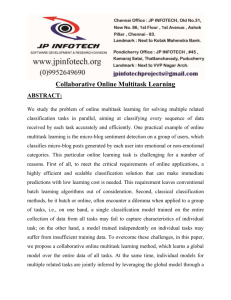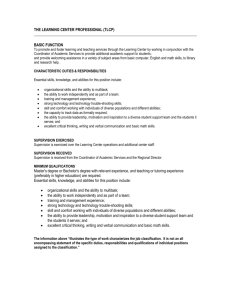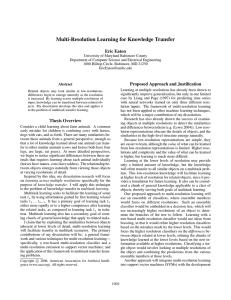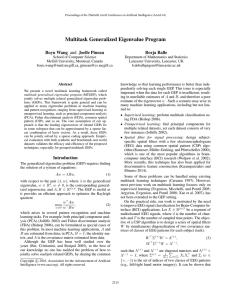schrum.beacon11
advertisement
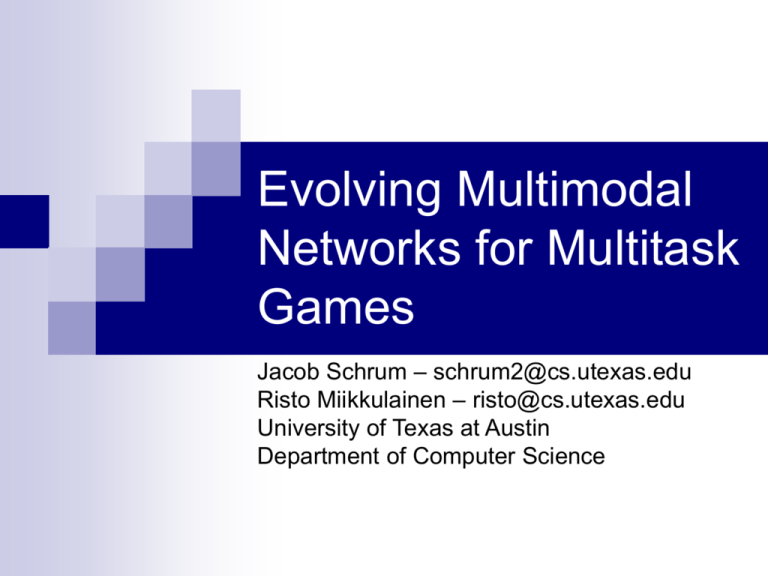
Evolving Multimodal
Networks for Multitask
Games
Jacob Schrum – schrum2@cs.utexas.edu
Risto Miikkulainen – risto@cs.utexas.edu
University of Texas at Austin
Department of Computer Science
Evolution in videogames
Automatically
learn interesting behavior
Complex but controlled environments
Stepping stone to real world
Robots
Training
simulators
Complexity issues
Multiple
contradictory objectives
Multiple challenging tasks
Multitask Games
NPCs perform two or more separate tasks
Each task has own performance measures
Task linkage
Independent
Dependent
Not blended
Inherently multiobjective
Test Domains
Designed to study multimodal behavior
Two tasks in similar environments
Different behavior needed to succeed
Main challenge: perform well in both
Front/Back Ramming
Same goal, opposite embodiments
Front Ramming
Attack
w/front ram
Avoid counterattacks
Back Ramming
Attack
w/back ram
Avoid counterattacks
Predator/Prey
Same embodiment, opposite goals
Predator
Attack
prey
Prevent escape
Prey
Avoid
attack
Stay alive
Multiobjective Optimization
Game with two objectives:
High health but did not deal much damage
Damage Dealt
Remaining Health
A dominates B iff A is
strictly better in one
objective and at least
as good in others
Population of points
not dominated are best:
Pareto Front
Weighted-sum provably
incapable of capturing
non-convex front
Tradeoff between objectives
Dealt lot of damage,
but lost lots of health
NSGA-II
Evolution: natural approach for finding optimal population
Non-Dominated Sorting Genetic Algorithm II*
Population P with size N; Evaluate P
Use mutation to get P´ size N; Evaluate P´
Calculate non-dominated fronts of {P P´} size 2N
New population size N from highest fronts of {P P´}
*K. Deb et al. A Fast and Elitist Multiobjective Genetic Algorithm: NSGA-II. Evol. Comp. 2002
Constructive Neuroevolution
Genetic Algorithms + Neural Networks
Build structure incrementally (complexification)
Good at generating control policies
Three basic mutations (no crossover used)
Perturb Weight
Add Connection
Add Node
Multimodal Networks (1)
Multitask Learning*
One
mode per task
Shared hidden layer
Knows current task
Previous work
Supervised
learning context
Multiple tasks learned
quicker than individual
Not tried with evolution yet
* R. A. Caruana, "Multitask learning: A knowledge-based source of inductive bias" ICML 1993
Multimodal Networks (2)
Starting network with one mode
Mode Mutation
MM Previous
Extra modes evolved
Networks choose mode
Chosen via preference neurons
Links from previous mode
Weights = 1.0
MM Random
Links from random
sources
Random weights
Supports mode deletion
MM(P)
MM(R)
Experiment
Compare 4 conditions:
Control:
Unimodal networks
Multitask: One mode per task
MM(P): Mode Mutation Previous
MM(R): Mode Mutation Random + Delete Mutation
500 generations
Population size 52
“Player” behavior scripted
Network controls homogeneous team of 4
MO Performance Assessment
Reduce Pareto front to single number
Hypervolume
of
dominated region
Pareto compliant
Front
A dominates
front B implies
HV(A) > HV(B)
Standard statistical
comparisons of
average HV
Front/Back Ramming Behaviors
Multitask
MM(R)
Predator/Prey Behaviors
Multitask
MM(R)
Discussion (1)
Front/Back Ramming
Control
< MM(P), MM(R) < Multitask
Multiple modes help
Explicit knowledge of task helps
Discussion (2)
Predator/Prey
MM(P),
Control, Multitask < MM(R)
Multiple modes not necessarily helpful
Disparity in relative difficulty of tasks
Multitask ends up wasting effort
Mode
deletion aids search for one good mode
How To Apply
Multitask good if:
Task
division known, and
Tasks are comparably difficult
Mode mutation good if:
Task
division is unknown, or
“Obvious” task division is misleading
Future Work
Games with more tasks
Does
method scale?
Control mode bloat
Games with independent tasks
Ms. Pac-Man
Collect pills while avoiding ghosts
Eat ghosts after eating power pill
Games with blended tasks
Unreal Tournament 2004
Fight while avoiding damage
Fight or run away?
Collect items or seek opponents?
Conclusion
Domains with multiple tasks are common
Both
in real world and games
Multimodal networks improve learning in
multitask games
Will allow interesting/complex behavior to
be developed in future
Questions?
Jacob Schrum – schrum2@cs.utexas.edu
Risto Miikkulainen – risto@cs.utexas.edu
University of Texas at Austin
Department of Computer Science


